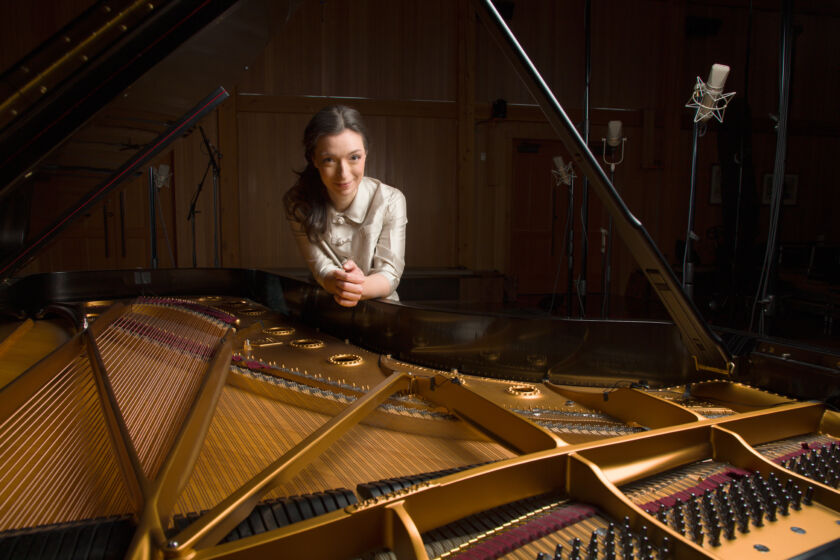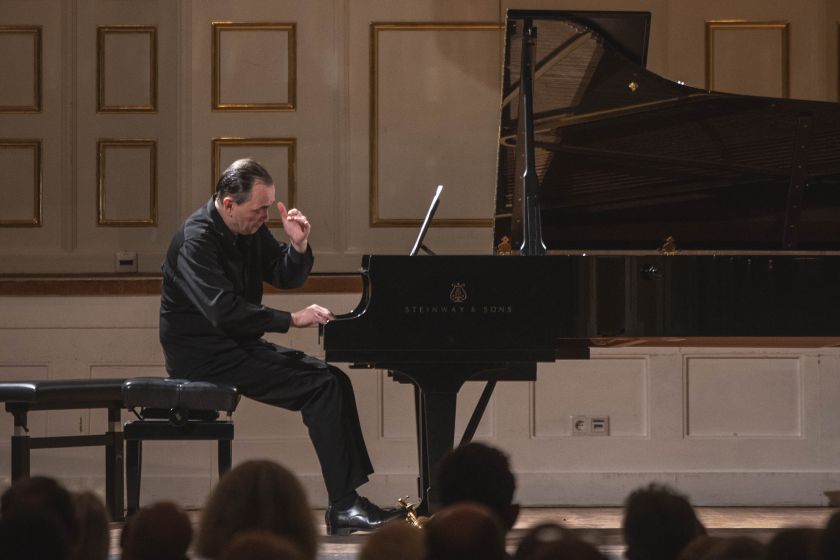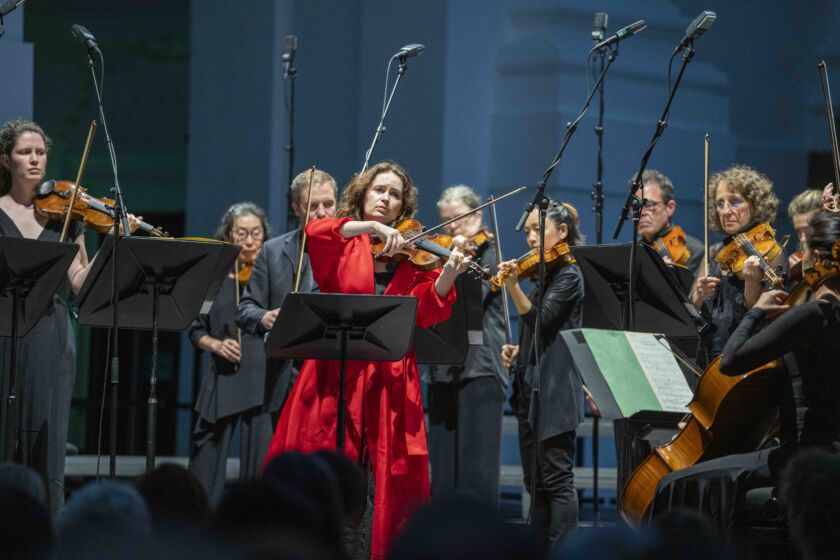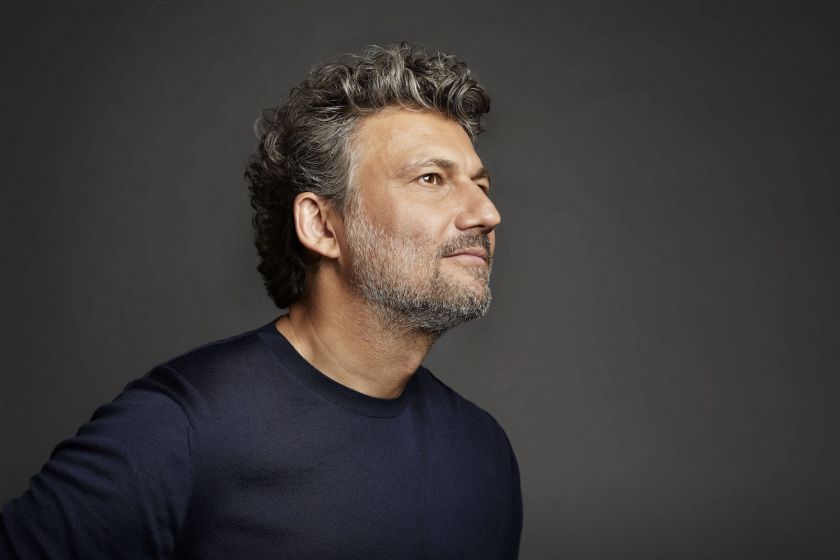Fugues, Sonatas and Landscapes of the Soul
Starting with Bach, the “beginning and end of all music“, the Solo Recitals and Song Recitals offer a colourful musical spectrum.


Bach “is the beginning and end of music”, the composer Max Reger once wrote into a book of friendship. It might also be the motto for the 2025 selection of solo recitals at the Salzburg Festival. Die Kunst der Fuge, the Art of the Fugue, one of the most intellectually challenging works of our music history, might be called its alpha and omega. The cycle of contrapuntal jewels will be heard in its entirety at the beginning of the Solo Recitals, played by András Schiff at the Mozarteum’s main auditorium (29 July). On 30 August, the Icelandic pianist Vikingur Ólafsson offers the last solo recital of the season at the Haus für Mozart, presenting a selection of works revolving around the tonal centre of E major and E minor. Bach’s Prelude from the first volume of Das wohltemperierte Klavier and his Partita BWV 830 meet Beethoven’s Sonatas Op. 90 and 109. The fact that E minor has traditionally been associated with the tender melancholy of love and similar moods jives with the report by Beethoven’s biographer Anton Schindler, who claimed that the composer set to music the unhappy affection of the dedicatee, Count Lichnowsky, for an opera singer, in his Opus 90. And Schubert, of course, was the master of expressive emotional lability, oscillating between major and minor keys.
A riddle for musicologists. But to return to the Art of the Fugue: so apparently abstract are the thoughts, the artificial accomplishment, the “glass bead game” of this music, that musicologists cannot even assign them to a certain sonic colour or instrument. Was it meant for the organ, or even for a piano (or harpsichord), as performances of our own times suggest? Was the master only interested in the intellectual challenge, the notation of solutions to riddles of compositional technique? We do not know. After all, the mystification of the Art of the Fugue is only heightened by the fact that the last “contrapunctus” remained unfinished, a quadruple fugue – a fugue with four themes, the last of which would have spelled “B-A-C-H” [in German notation]. The manuscript ends as soon as this appears.
The preludes and fugues Bach collected in the two volumes of Das wohltemperierte Klavier confront us with far fewer riddles. With this journey through all the major and minor keys, to which European music has become so thoroughly accustomed, tonality as we know it really begins. Pierre-Laurent Aimard, who will perform a selection from the second volume of the collection at the Mozarteum on 22 August, has at least answered the question – violently disputed by some aesthetes – for himself whether it is permissible to play Bach on a modern concert grand piano. It is; and the listeners will occasionally have a warm feeling in their hearts during some of the preludes and fugues, because unlike in Die Kunst der Fuge, this music is not removed from and lost to the world, but is decidedly of this world, expressive, and occasionally of great playfulness, even amusing.

An alarming kaleidoscope. To a certain extent, Dmitri Shostakovich at least adopted this diversity of content from Bach when he set out to write a sequence of preludes and fugues. A selection of this Opus 87 will be played on 16 August by Yulianna Avdeeva; she juxtaposes them with the cycle of Préludes Op. 28 by Frédéric Chopin, who turns the supposedly short forms into an alarming kaleidoscope of subjective feelings, and makes the music, which seems so innocuous at first, finally plunge into an abyss after undergoing a multitude of emotional extremes.
It is a great injustice to Chopin that it has become common to take individual preludes out of the context of this cohesive conglomerate the composer devised, following Bach’s model of traversing all the key signatures. Without knowing the greater context, the pieces give a false impression. This form of belittling trivialization also befell the Viennese romanticist Franz Schubert. In his case, even individual songs were filleted, removing unpopular disturbing elements, anything likely to disrupt the supposed idyll of the “Dreimäderlhaus”. Festivals offer an opportunity to set records straight and offer new perspectives – also in the case of music which has fallen prey to the habituation effect because it is performed too often. Thus, curious listeners can experience two different renditions of Die schöne Müllerin within just a few days, one by Florian Boesch in an arrangement of the piano accompaniment for the Musicbanda Franui (12 August) and another by Georg Nigl, whom Alexander Gergelyfi accompanies on a historical square piano at the Stefan Zweig Centre (14/15 August) – an intimate occasion which actually creates something akin to the situation in which the songs would originally have been performed.
Two piano recitals at the Festival contribute to the “desaccharination” of Schubert’s image: on 27 August, Igor Levit combines the last, epic Piano Sonata of the composer (in B-flat major, D 960) with Chopin’s Sonata in B minor and the Nachtstücke Op. 23 by Robert Schumann, a combination that guarantees an insightful listening experience. Arcadi Volodos dedicates himself exclusively to Schubert on 12 August, building bridges from the popular but profound Moments musicaux to Liszt arrangements of songs expressing a death wish (“Am Tage Aller Seelen” and “Der Müller und der Bach” from Die schöne Müllerin, bringing the total of Schöne Müllerinnen to three this summer) and the middle one of the three sonatas from the last months of Schubert’s life: the work in A major (D 959) is among the composer’s most mysterious compositions, straying in its second movement from a supposed idyll into an inferno from which there seems to be no exit for a breathtakingly long time.

Argentine past. Pianistic brilliance and profundity can also be found in Daniil Trifonov’s appearance on 31 July, which features a programme indebted to dance: in addition to Chopin waltzes and a suite from Tchaikovsky’s ballet Sleeping Beauty, there is the rarely-played Third Piano Sonata by Tchaikovsky and Samuel Barber’s only Sonata in E-flat minor, his central piano work which is rarely played for no discernible reason. None less than Vladimir Horowitz gave its world premiere at Carnegie Hall in 1950 and made a studio recording of it the same year. However, it was also Horowitz who had requested “a very brilliant last movement, but with content” for the work, which had originally only contained three movements and ended with a slow, explicitly sad finale. We know how seriously Barber took this advice in his subsequent final fugue from an anecdote in which the pianist Walter Gieseking played the first three movements prima vista with great enthusiasm. It was only in the fugue that he got stuck…
Only a few days later, on 4 August, music lovers attending the recital by Evgeny Kissin can encounter another piano sonata with a very personal touch, Dmitri Shostakovich’s Sonata No. 2 Op. 61, which was written after the “Leningrad Symphony” in 1943 as a kind of musical self-exploration by the composer, drawing upon several avant-garde elements which he had been “prohibited” from using by the official cultural policy of the Soviet Union. Kissin juxtaposes this work with highly romantic, no less subjectivist Chopin pieces and one of the Piano Partitas by Johann Sebastian Bach.
A daring parade of pianistic challenges of French modernism makes up the garland Pierre-Laurent Aimard weaves for Pierre Boulez on 22 August, celebrating his anniversary. Furthermore, two important violinists dedicate themselves to variations on late romanticism and impressionism (Franck, Debussy and Szymanowski with María Dueñas and Alexander Malofeev on 5 August) and the blossoming and destruction of classical formal worlds (Beethoven, Schoenberg and George Antheil with Patricia Kopatchinskaja and Joonas Ahonen on 25 August).

Manifold song recitals. The series of song recitals at the 2025 Salzburg Festival describes a musical arch that is at least as broad. Apart from the above-mentioned Schubert programmes with Florian Boesch and Georg Nigl, there is another all-Schumann evening by Christian Gerhaher with Gerold Huber at the piano (28 July). The duo of Diana Damrau and Jonas Kaufmann returns with Helmut Deutsch at the piano to juxtapose works by the two antipodes Gustav Mahler and Richard Strauss (30 July).
The Festival founder Richard Strauss and his role model Richard Wagner (Wesendonck Lieder) encounter each other when Andrè Schuen and Daniel Heide perform on 16 August, while the versatile soprano Sabine Devieilhe is joined at the piano by Mathieu Pordoy on 3 August to luxuriate in French “mélodies”, from Gabriel Fauré’s love songs and Debussy’s Ariettes oubliées to sophisticated vocal miniatures by Maurice Ravel and Albert Roussel and enigmatic chansons by Francis Poulenc.
Text: Wilhelm Sinkovicz
Translation: Alexa Nieschlag
Zuerst erschienen am 31.05.2025 in Die Presse Kultur Spezial: Salzburger Festspiele
